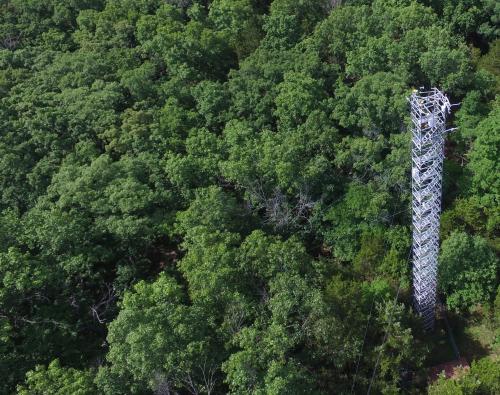Isoprene is primarily emitted by plant foliage under warm and sunny conditions. Accurate knowledge on its emissions is needed to better assess the formation of ozone and fine particles and their impact on air quality and climate. However, the impact of deforestation and drought stress on isoprene emissions are grey areas in our current knowledge. The goal of ALBERI was to better describe the response of isoprene emissions to vegetation changes and drought in the biogenic emission model MEGAN.
What is the impact of land cover changes and drought on isoprene emissions?
The global isoprene emission trends due to warming climate are estimated by the MEGAN model to be ca. 10% per decade since 2001. When land cover changes are accounted for, the simulations show a drop in the emission trend, to 6% per decade. This mitigating effect is mainly due to the decline in tree cover in the Tropics.
Laboratory studies have shown that, when plants suffer moderate water stress, isoprene emissions increase due to higher leaf temperature but decrease in case of severe or prolonged drought due to reduced photosynthesis. Field observations of the effects of natural drought on isoprene fluxes at ecosystem-scale are scarce. During the 2011–2012 field campaigns in central U.S., at the MOFLUX site, isoprene fluxes were monitored for two summers concomitant to drought events, providing us with a unique dataset.
In our study, we readjust the drought parameterization of the MEGAN model based on the MOFLUX measurement dataset and satellite-based soil moisture data from the GLEAM model developed at Ghent University. The evaluation method is based on formaldehyde (HCHO), a high-yield product in the oxidation of isoprene that can be measured from space and calculated using a chemistry-transport model.
We compare HCHO columns from the chemistry-transport model IMAGES to HCHO observations by the Ozone Monitoring Instrument, OMI. The use of the readjusted parameterization shows an overall improvement in HCHO columns at the MOFLUX site, but the comparisons also highlight the limitations of using highly heterogeneous soil properties as drought indicators.
A springboard for future research
Other possible avenues should be explored, such as the use of terrestrial evapotranspiration. Given the lack of isoprene observations in dry conditions, continuous monitoring of fluxes is therefore urgently needed. Since 2022, isoprene fluxes have been regularly measured at the Vielsalm site in the Belgian Ardennes and will allow us to better assess its drivers.
Partners
References
- Opacka, B., J.-F. Müller, T. Stavrakou, M. Bauwens, K. Sindelarova, J. Markova, A. Guenther: Global and regional impacts of land cover changes on isoprene emissions derived from spaceborne data and the MEGAN model, Atmos. Chem. Phys. 21, 8413–8436, https://doi.org/10.5194/acp-21-8413-2021, 2021.
- Opacka, B., J.-F. Müiler, T. Stavrakou, D. G. Miralles, A. Koppa, B. R. Pagan, M. J. Potosnak, R. Seco, I. De Smedt, A. B. Guenther: Impact of drought on isoprene fluxes assessed using field data, satelite-based GLEAM soil moisture and HCHO observations from OMI. Remote Sens., 14, https://doi.org/10.3390/rs14092021, 2022.

